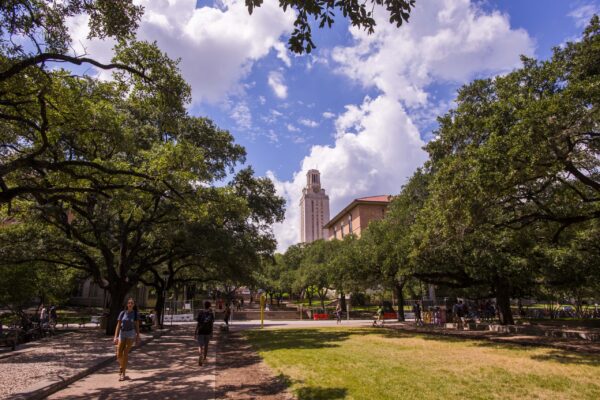AUSTIN, Texas — When students, faculty, staff and visitors walk across the UT Austin campus a few years from now, they’ll see a significantly different East Mall from what exists today. Announced in summer 2020 by President Jay Hartzell, a new initiative is underway to re-envision the East Mall landscape as a celebration of the history and impact of the Precursors, UT’s first generation of Black students.
As its working title suggests, the “We Are Texas East Mall Commemorative Space” project aims to enrich our sense of community and belonging. The redesigned space will honor the Precursors within a larger East Mall area dedicated to community members who helped advance the university’s commitment to serve the entire state of Texas and people of every background, race and life experience.
“We are excited and proud to honor the Precursors, whose perseverance in the face of extraordinary challenges helped pave the way for the opportunities our Longhorns enjoy today,” President Hartzell said. “It has been extremely rewarding to see our community come together to reimagine this prominent campus space as a reflection of our university’s core values and our incredibly diverse and talented students, faculty, staff and alumni.”
After an extensive proposal and evaluation process, the university has selected MASS Design Group to help realize the East Mall vision. The award-winning nonprofit firm has achieved global recognition for creating inspiring structures and spaces from McKinney, Texas, to Butaro, Rwanda. Most recently, they received the American Institute of Architects’ 2022 AIA Architecture Firm Award for producing distinguished architecture for more than a decade.
“On behalf of the Precursors, we applaud President Hartzell and all engaged in this project for following through with their commitment to honor the first Black undergraduates allowed to enroll at The University of Texas at Austin and recognize the contribution these courageous pioneers made to ensure that the university would be more reflective of our state’s cultural and racial mosaic,” said Precursors President Cloteal Haynes.
“‘The Complete Story.’ Those are the three words that come to mind when I reflect on the transformation of the East Mall into a space that reflects an important chapter of the university’s history: the Precursors,” said Rudy Metayer, executive director of the Texas Black Caucus Foundation.
“We are in a moment in time when history is being forgotten or washed away. So, when the flagship institution of Texas makes a commitment to not just honor those brave women and men who helped pave the path for me and others like me to attend the university, but also make sure their history is on display for all to see, it is simply awe inspiring.” Metayer said. “President Hartzell and other campus leaders have shown a sensitivity and care to the concerns many have expressed through the years about the inclusivity of the university. And its missing history. This is an important step toward making The University of Texas reach its potential as a welcoming place for not some Texans, but all.”
Realizing a Vision of Inclusivity
Part of the university’s Contextualization and Commemoration Initiative (CCI), the East Mall project is one of many initiatives aimed at honoring those who opened doors for future generations and telling the public history narratives of UT’s interactions with the diverse residents and groups of the state of Texas.
“These projects place UT’s past in a new light,” said Edmund T. Gordon, associate professor of African and African diaspora studies and executive director of CCI. “Rather than a narrative of the university’s attempt to overcome an exclusionary past, they propose an alternative understanding. Our university is an institution of the state and of its time, and today that means establishing an expanding vision of inclusivity. Through these commemorative projects, UT can assert its commitment to equity and inclusivity as a job not completed but well begun.”
In addition to the East Mall project, CCI has several other initiatives underway, including a commemorative exhibit and space dedicated to Heman M. Sweatt. In 1946, Mr. Sweatt was denied admission to the University of Texas School of Law on the basis of race. He brought legal action that resulted in the United States Supreme Court ruling that separate law school facilities could not provide a legal education equal to the University of Texas School of Law. The ruling established an important precedent for the desegregation of graduate and professional schools and helped pave the way for Black undergraduate students’ admission to formerly segregated colleges and universities across the nation.
CCI also has 17 scholarly research projects in the works — covering topics ranging from Mexican American history at the university to UT’s role in American legal history — that will guide the design and development of commemorative structures on campus, elevate our community’s understanding of public history and catalyze scholarly publications.
The work of CCI builds upon UT’s broader commitment to fostering a culture in which all students, staff and faculty can thrive. In April 2021, the Office of the Executive Vice President and Provost launched the Strategic Plan for Faculty Diversity, Equity and Inclusivity, and in May 2022, the university launched the first phase of You Belong Here, a three-year community-wide plan for an equitable and inclusive campus.
Beginning this fall, CCI will work with MASS Design Group to engage representatives of the campus community in the continued research, development and implementation of the East Mall vision. You can learn more about the project’s progress and all CCI initiatives at provost.utexas.edu/the-office/diversity/campus-contextualization-and-commemoration-initiatives/.




